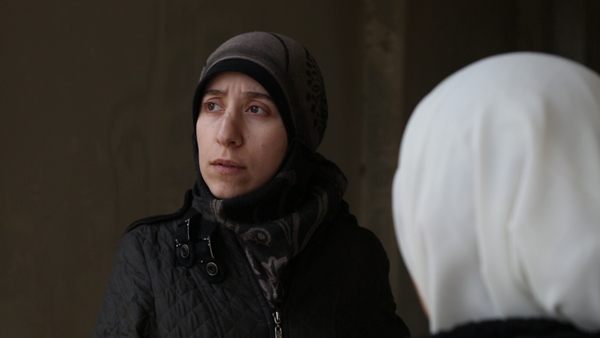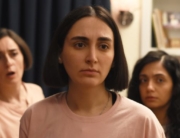

As the government forces and the Russian allies of Syrian President Bashar al-Assad bomb Eastern Al Ghouta (bordering Damascus) and trap 400,000 civilians, a hospital goes underground, setting up shop in a network of tunnels and a basement labyrinth, reinforced by beams and cement bricks. Most of the volunteer doctors are students, with operations often performed during shelling.
Dr. Salim Namour operates while listening to the Vienna State Orchestra on his smartphone; the music is meant to calm patients because of the lack of anesthesia—smartphones also become the lifeline to the outside world for the 150-member staff. Electrical outages are common, medicine scarce, and food for patients nonexistent. As the siege continues, children die of malnutrition. Additionally, the filmmakers are in place to record the chemical attack in March 2018, when the staff observes dying patients with no visible injuries and the heavy smell of chlorine. This assault led to the Trump administration, along with Britain and France, to bomb three Syrian chemical weapon facilities in April 2018.
Briskly paced and with many incredibly intense moments, The Cave was filmed in this war zone from 2016-18 by Damascus-born cinematographers Muhammed Khair Al Shami, Ammar Sulaiman, and Mohammed Eyad. Syrian director Feras Fayyad, unable to travel to the city because of the siege, consulted daily with his team, which compiled several hundred hours of footage. (After making a documentary, On the Other Side, about an exiled Syrian poet, Fayyad was imprisoned and tortured for 15 months during al-Assad’s early crackdown of the growing pro-democracy movement.)
The small digital Cannon cameras mostly follow managing director Amani Ballor, a 30-year-old medical student studying to be a pediatrician, and the filmmakers base her interwoven voice-over on her diary. Fayyad first met her when he made his Academy Award–nominated 2017 documentary Last Men in Aleppo, which profiled the volunteers, known as the White Helmets, who risked their lives to rescue civilians from the rubble of the military strikes targeting hospitals.
His new film captures both the downtime and the moments of crisis that medical staff experiences underground. In the stillness, nurse Samaher listens for the sound of shelling to determine how close a strike is to the hospital while she makes a meal to feed the entire staff. (Water is scarce for the rice; the complaining but hungry men eat it anyway. However, her falafel is a success.)
In response to the ongoing Syrian civil war, a documentary subgenre has emerged. Many of these are made up of street-level videos, often filmed with cell phones, by journalist activists. Besides the previously mentioned Last Men in Aleppo, The War Show, from 2016, compiled videos of the Syrian regime’s attacks on young antigovernment activists, many of whom were killed or tortured during the film’s making. For Sama, which came out earlier this year, is as compelling as The Cave. Journalist Waad al-Kateab records a diary for her infant daughter to explain why she and her husband, a surgeon, remain in a besieged Aleppo, even when the family has a chance to flee the country. (This film doesn’t hold back; many children die on camera.) The Cave, though, has more cinematic touches than the others, with sweeping cityscapes shot in 65mm of the Damascus suburb under attack.
What also distinguishes this film from other reporting is the focus on Amina and the hostility that she arouses among men because of her position. Early on, a disgruntled husband who’s searching for medicine for his wife reprimands her, barking that she should stay home where she belongs. She has allies, though. Her colleague Dr. Salim stands up for her: it takes teamwork, not one individual, to run a hospital.
Dr. Amina doesn’t hold back on her opinions either. She condemns the “racist and autocratic regime” of President al-Assad and decries the cultural limits that have been placed on women: “Religion is just a tool for men,” to take what they want from it. Arguably the documentary’s centerpiece involves Amina comforting an adolescent girl, whose father died in a car bombing. As she braids the youth’s hair, she challenges the adolescent to aspire to become someone important—maybe a doctor or teacher?
A month ago when I first saw the film, it was questionable whether this, or any documentary, could change hearts and minds regarding foreign intervention in Syria. But given the rapidly changing events in the last two weeks, with Turkey invading the northern areas of Syria held by Kurds and Russian and Syrian government forces also moving into the zone, this film will become a reference point on an ongoing time line. The movie’s opening titles, which explain the background of the hospital, warns that for those remaining in Al Ghouta, “There is no way out,” a phrase which now has taken on a new resonance.






Leave A Comment